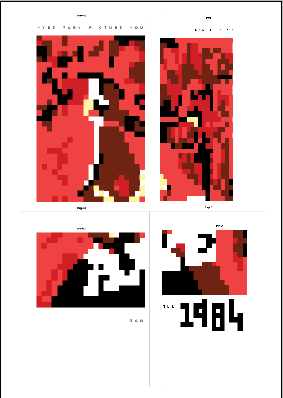1966 first edition,
designed by S. Neil Fujita
For this design Fujita
proposed to Capote that the hatpin at the top of this austere jacket
should have a red bulb at one end to appear like a swollen drop of
blood. However, Capote objected to this because the crime was old, so
the blood would no longer be bright red. As a result the colour was
made burgundy and a funeral black border was added to the outside of
the jacket. This suggests that the jacket should show some history,
bright colours might make it too fresh and out of character. However,
boundaries could be broken to make it so electric and bright, the
story is reinvented.
1994
edition, Vintage Books USA
This
edition uses one faded photograph for its cover. The cover
communicates a sense of the bleak, loneliness that runs throughout
the killers in the book. The soft colours indicate its age once
again, yet the type is more modern this time. The sans serif creates
a contemporary effect, however it also makes it too 'clean'; the
typeface should be more classic and vintage to represent the book's
content. The clouds also appear very unrelated to the content and are
not really enough to surmise the dark and twisted nature of the book.
Published
2000 by Penguin Classics
by Andy Bridge
This
is an illustrations of the riffle used to kill the Clutter family.
The design uses quite dulled colours even though the contrast is
high. Although this grabs attention, perhaps it is still too bright
to communicate the dark and dreary feeling created by the murders.
Although it is certainly dramatic and conveys the style of the 60s.
The bird in the centre could link to the freedom that the two men are
desperately trying to reach, which does give the cover further subtle
meaning. Again they have have used a dull red instead of a bright
red, possibly linking back to the original design (the blood is old.)
2004
edition- Soğukkanlılıkla by Gülay Tunç (Turkish design)
This
is quite a unique jacket and it is characterised by it's Turkish
design. The colours are bright and the red contrasts dramatically
with the black. The silhouettes are sharp and crisp, they are very
stylised, opposed to a more natural approach. This creates a more
artificial aesthetic, which in some ways works to represent the
forced, unnatural aspect of murder. Although this is quite a modern
response it helps to freshen the story and make it more accessible.
























































